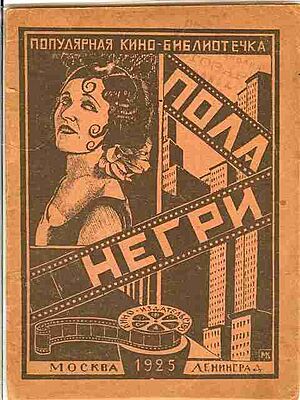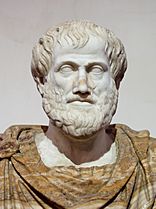Ayn Rand facts for kids
Quick facts for kids
Ayn Rand
|
|
|---|---|

Rand in 1943
|
|
| Native name |
Алиса Зиновьевна Розенбаум
|
| Born | Alisa Zinovyevna Rosenbaum February 2, 1905 Saint Petersburg, Saint Petersburg Governorate, Russian Empire |
| Died | March 6, 1982 (aged 77) New York City, U.S. |
| Pen name | Ayn Rand |
| Occupation | Writer |
| Language | English |
| Citizenship |
|
| Alma mater | Leningrad State University |
| Period | 1934–1982 |
| Notable works |
|
| Spouse |
Frank O'Connor
(m. 1929; died 1979) |
| Signature | |
 |
|
Ayn Rand (born Alisa Zinovyevna Rosenbaum; February 2, 1905 – March 6, 1982) was a famous Russian-born American writer and philosopher. She is best known for her novels and for creating a way of thinking called Objectivism.
Born and raised in Russia, she moved to the United States in 1926. After writing a few early novels and plays, she became famous with her 1943 novel, The Fountainhead. In 1957, Rand published her very popular book, Atlas Shrugged. After this, she focused on writing non-fiction to share her philosophy until she passed away in 1982.
Ayn Rand believed that reason is the only way to gain knowledge. She did not believe in faith or religion. She supported rational self-interest instead of always putting others first. In politics, she was against using force and was against collectivism (where the group is more important than the individual). She supported laissez-faire capitalism, which means a system where individuals have rights, including private property rights. Rand's books have sold over 37 million copies worldwide.
Life Story
Early Years
Ayn Rand was born Alisa Zinovyevna Rosenbaum on February 2, 1905, in Saint Petersburg, Russia. Her family was well-off. When she was twelve, the October Revolution happened, and the Bolsheviks took control. Her father's business was taken by the government. Her family had to move and faced hard times, sometimes even going hungry.
After the revolution, Russian universities allowed women to attend. Rand was one of the first to enroll at Petrograd State University. She studied history. She finished her studies in 1924 at what was then called Leningrad State University. She then studied screen arts for a year. Her first published work was an essay about an actress. Around this time, she chose her pen name, Ayn Rand.
In 1925, Rand got a visa to visit relatives in Chicago. She arrived in New York City in February 1926. She wanted to stay in the United States and become a screenwriter. She learned English and then moved to Hollywood.
In Hollywood, she met famous director Cecil B. DeMille. This led to her working as an extra in his film The King of Kings. She then got a job as a junior screenwriter. While working, she met an actor named Frank O'Connor. They got married on April 15, 1929. She became a permanent American resident in 1929 and an American citizen in 1931.
Early Novels and Plays
Rand's first success was selling her screenplay Red Pawn in 1932. Her play Night of January 16th was first performed in Hollywood in 1934. It then became a success on Broadway in 1935. A unique part of the play was that a jury was chosen from the audience each night. Their vote decided which of two different endings would be performed.
Her first novel, We the Living, came out in 1936. It was partly based on her own life. The story is set in Soviet Russia and shows the challenges between an individual and the government. Later, after her other novels became popular, she released a new version of We the Living in 1959. This version has sold over three million copies.
Rand also wrote a shorter novel called Anthem in 1937. It describes a future world where totalitarian collectivism has taken over. People have forgotten the word I and only use we. It was published in England in 1938. Like We the Living, a revised version was published in 1946 after her later success. This book has sold over 3.5 million copies.
The Fountainhead and Political Work
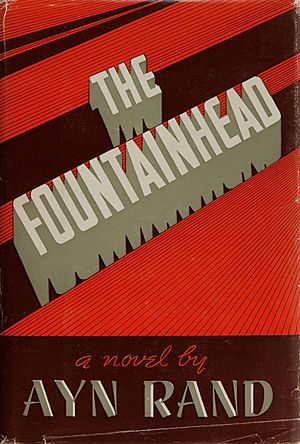
In the 1940s, Rand became more involved in politics. She and her husband volunteered for a presidential campaign. This led her to meet other thinkers who supported free-market capitalism. She became friends with journalist Henry Hazlitt and economist Ludwig von Mises. Rand admired their ideas, and they admired her work.
Rand's big breakthrough as a writer happened in 1943 with The Fountainhead. This novel is about an architect named Howard Roark. He refuses to compromise his ideas and fights against people who live through others. Many publishers rejected the book before it was finally accepted.
The success of The Fountainhead made Rand famous and financially secure. She sold the film rights to Warner Bros. in 1943. She went back to Hollywood to write the screenplay for the movie. She also worked as a screenwriter for other films.
While in Hollywood, Rand joined groups that were against Communism. In 1947, she spoke to the United States House Un-American Activities Committee. She said that a 1944 film called Song of Russia showed life in the Soviet Union as much better than it really was. The film version of The Fountainhead was released in 1949. Even though it used her screenplay, Rand did not like the movie.
Atlas Shrugged and Objectivism
After The Fountainhead, Rand received many letters from readers who were deeply moved by her book. In 1951, Rand moved to New York City. There, she gathered a group of admirers, including Alan Greenspan, who later became a very important economist. This group met with Rand to talk about philosophy. Rand also let them read drafts of her new novel, Atlas Shrugged.
Atlas Shrugged, published in 1957, is seen as Rand's most important work. She said the book was about "the role of the mind in man's existence." It also showed a new moral philosophy: the idea of rational self-interest. The story is set in a future United States where creative people go on strike. They hide in a secret valley and build their own free economy. The novel's hero, John Galt, explains that they are stopping "the motor of the world" by taking away the minds of those who contribute most to the nation's wealth.
Even though many critics gave Atlas Shrugged negative reviews, it became a worldwide bestseller. Atlas Shrugged was her last completed fiction book. After this, she focused on sharing her philosophy, Objectivism, with the public.
In 1958, Nathaniel Branden started a group to promote Rand's philosophy through public talks. He and Rand also started a newsletter to share articles about her ideas. Rand was very strict with her students and followers. She sometimes reacted strongly to those who disagreed with her.
Later Years
Throughout the 1960s and 1970s, Rand continued to develop and share her Objectivist philosophy. She wrote non-fiction books and gave talks at colleges and universities. She often spoke about current political and social issues.
In 1968, Rand ended her relationship with Nathaniel Branden. She published an article saying he was dishonest. Over the next few years, other close friends also parted ways with her.
Rand had surgery for lung cancer in 1974. In 1976, she stopped writing her newsletter. She also allowed herself to be enrolled in Social Security and Medicare, which are government programs. Her activities in the Objectivist movement slowed down in the late 1970s, especially after her husband passed away in 1979.
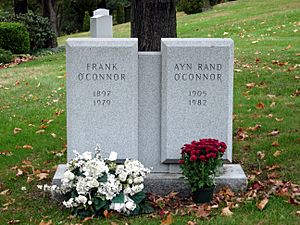
Ayn Rand died on March 6, 1982, from heart failure at her home in New York City. At her funeral, a large flower arrangement shaped like a dollar sign was placed near her casket. She named Leonard Peikoff as her heir.
Literary Style and Influences
Literary Approach
Rand called her writing style "romantic realism". She wanted her stories to show the world "as it could be and should be," not just as it was. This meant she created very specific situations and characters. Her main characters are usually heroic individuals who are strong and attractive. Her villains often represent duty and group-focused ideas. Rand often described them as unattractive.
Rand believed that the plot was very important in literature. Her stories usually have "tight, elaborate, fast-paced plotting." Love triangles are also common in her fiction. In most of her novels, the main female character is involved with at least two men.
Influences
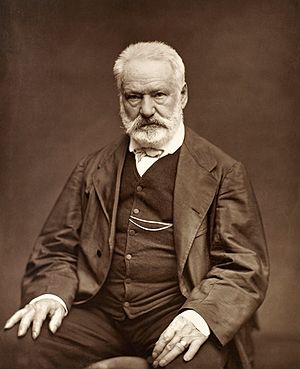
In school, Rand enjoyed reading books by Fyodor Dostoevsky, Victor Hugo, Edmond Rostand, and Friedrich Schiller. She thought they were among the best Romantic writers because they focused on moral themes and were good at creating plots. Victor Hugo was a big influence on her writing, especially how she built her plots. She called him "the greatest novelist in world literature."
Rand's experiences during the Russian Revolution and early Communist Russia also influenced her writing. This can be seen in the ideas of characters like Ellsworth Toohey in The Fountainhead, and in the way the economy falls apart in Atlas Shrugged.
Rand's descriptive writing style is similar to how early Hollywood movie scripts were written. Her novels often have descriptions that look like movie scenes. They often start with a wide view of a scene and then zoom in on details.
Philosophy (Objectivism)
Rand named her philosophy "Objectivism." She described it as "the concept of man as a heroic being, with his own happiness as the moral purpose of his life, with productive achievement as his noblest activity, and reason as his only absolute." She thought Objectivism was a complete system of ideas. It covered topics like metaphysics (the nature of reality), aesthetics (art and beauty), epistemology (how we know things), ethics (morality), and political philosophy (how society should be run).
Reality and Knowledge
In her ideas about reality, Rand believed in philosophical realism. This means she thought reality exists independently of our minds. She was against anything she saw as mystical or supernatural, including all forms of religion. Rand believed in free will, meaning people can make their own choices, and she rejected the idea that everything is already decided.
When it came to art, Rand said art is like a "selective re-creation of reality." It shows reality based on what the artist thinks is important. She believed art helps us understand big ideas in a clear way. As a writer, she focused on literature. She thought romanticism best showed human free will.
In her ideas about knowledge, Rand believed all knowledge comes from what we see, hear, touch, taste, and smell (sense perception). She thought that our senses are reliable. She also believed in reason, which she called "the faculty that identifies and integrates the material provided by man's senses." Rand did not believe in knowledge that comes from "instinct," "intuition," or "revelation." She thought that using reason was the most important part of her philosophy.
Ethics and Politics
In ethics, Rand argued for rational egoism (rational self-interest) as the main moral rule. She said that each person should "exist for his own sake." This means not sacrificing oneself for others, and not sacrificing others for oneself. Rand called egoism "the virtue of selfishness" in her book with that title. She believed that always putting others first (altruism) was not good for human life or happiness. She also believed that starting force against others was wrong and illogical.
Rand's political ideas focused on individual rights, including the right to private property. She believed that laissez-faire capitalism was the only moral social system. This is because, in her view, it was the only system that protected individual rights. Rand was against collectivism and statism. These include many types of government like communism, fascism, socialism, and the welfare state. She preferred a constitutional republic where the government's only job is to protect individual rights. Even though her political views are sometimes called conservative or libertarian, Rand preferred the term "radical for capitalism."
Her View on Other Philosophers
Ayn Rand was very critical of most philosophers and their ideas, except for Aristotle, Thomas Aquinas, and classical liberals. She said Aristotle was her biggest influence. In a 1959 interview, she said her philosophy came "Out of my own mind, with the sole acknowledgement of a debt to Aristotle, the only philosopher who ever influenced me."
Rand believed her philosophical opposite was Immanuel Kant. She called him "the most evil man in mankind's history." She thought his ideas about knowledge weakened reason and his ethics were against self-interest. She was also critical of Plato.
Rand was not a university professor and did not take part in academic discussions. She often wrote about ideas she disagreed with in a strong, argumentative way. Many academic philosophers did not take her seriously.
Selected works
Fiction and drama:
- Night of January 16th (performed 1934, published 1968)
- We the Living (1936, revised 1959)
- Anthem (1938, revised 1946)
- The Unconquered (performed 1940, published 2014)
- The Fountainhead (1943)
- Atlas Shrugged (1957)
- The Early Ayn Rand (1984)
- Ideal (2015)
Non-fiction:
- For the New Intellectual (1961)
- The Virtue of Selfishness (1964)
- Capitalism: The Unknown Ideal (1966, expanded 1967)
- The Romantic Manifesto (1969, expanded 1975)
- The New Left (1971, expanded 1975)
- Introduction to Objectivist Epistemology (1979, expanded 1990)
- Philosophy: Who Needs It (1982)
- Letters of Ayn Rand (1995)
- Journals of Ayn Rand (1997)
See Also
 In Spanish: Ayn Rand para niños
In Spanish: Ayn Rand para niños


